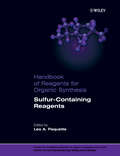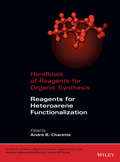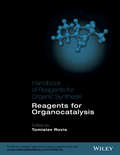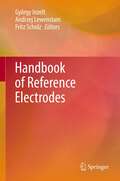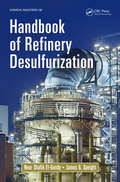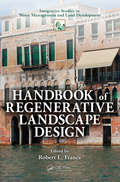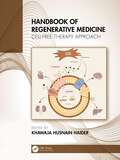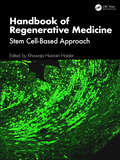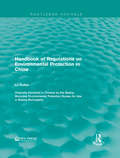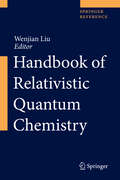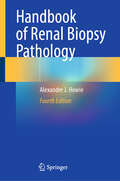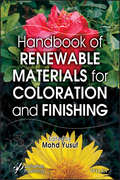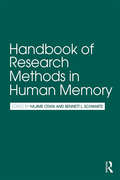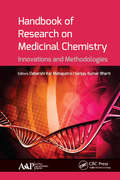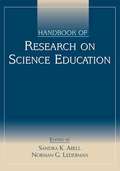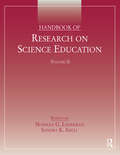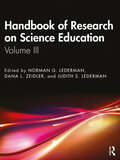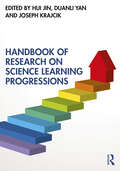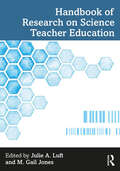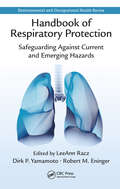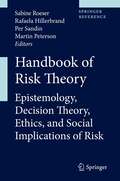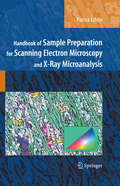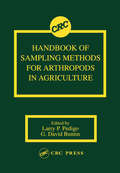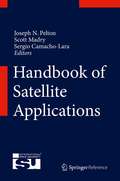- Table View
- List View
Handbook of Reagents for Organic Synthesis, Sulfur-Containing Reagents
by Leo A. PaquetteThere are a lot of books available about the chemistry and biology of sulfur. However, this is the first book with a compilation of all relevant Sulfur containing reagents. Synthetic chemists, most particularly in the medicinal and pharmaceutical chemists, are often called upon to prepare compounds that contain Sulfur as a key structural feature. In the past, this seemed to be a domain for specialists; today every synthetic chemist working in these area is expected to synthesize compounds containing sulfides, sulfates, sulfones, etc. This book offers an important source of information for the selection and handling of the right reagents.
Handbook of Reagents for Organic Synthesis: Reagents for Heteroarene Functionalization
by André B. CharetteHeteroarenes are among the most prevalent structural units in natural products, pharmaceuticals, agrochemicals, and other compounds of scientific or commercial interest. In the last decade, a broad range of novel synthetic methods has been developed to not only facilitate construction of the heteroarene motif, but to enable its modification through direct C–H functionalization. This Handbook describes 117 key reagents for selective heteroarene functionalization reactions, including both traditional and transition metal-catalyzed C–H functionalization. Since these reactions typically involve one heteroarene, a coupling partner and a catalyst, the handbook not only focuses on the catalyst itself but also contains other key reaction species. All the information compiled in this volume is also available in electronic format on Wiley Online Library. The 117 reagents represented here are but a small fraction of the ca. 5,000 reagents available in the electronic Encyclopedia of Reagents for Organic Synthesis (e-EROS). e-EROS offers various search interfaces to locate reagents of interest, including chemical structure, substructure and reactions search modes. e-EROS is updated regularly with new and updated entries.
Handbook of Reagents for Organic Synthesis: Reagents for Organocatalysis
by Tomislav RovisSpurred by the desire to make chemistry a sustainable and "greener" technology, the field of organocatalysis has grown to become one of the most important areas in synthetic organic chemistry. Organic catalysts can often replace potentially toxic metal catalysts and allow reactions to proceed under mild reaction conditions, thereby saving energy costs and rendering chemical processes inherently safer. More importantly perhaps, organocatalysis offers a complementary reactivity in many instances leading to increased versatility. This Handbook describes 126 key reagents for organocatalytic reactions and will be especially useful for professionals in the area of sustainable chemistry, medicinal research, as well as synthetic organic chemists working in academia and the pharmaceutical industry. All the information compiled in this volume is also available in electronic format on Wiley Online Library. The 126 reagents represented here are but a small fraction of the ca. 5,000 reagents available in the electronic Encyclopedia of Reagents for Organic Synthesis (e-EROS). e-EROS offers various search interfaces to locate reagents of interest, including chemical structure, substructure and reactions search modes. e-EROS is updated regularly with new and updated entries.
Handbook of Reference Electrodes
by Fritz Scholz Andrzej Lewenstam György InzeltReference Electrodes are a crucial part of any electrochemical system, yet an up-to-date and comprehensive handbook is long overdue. Here, an experienced team of electrochemists provides an in-depth source of information and data for the proper choice and construction of reference electrodes. This includes all kinds of applications such as aqueous and non-aqueous solutions, ionic liquids, glass melts, solid electrolyte systems, and membrane electrodes. Advanced technologies such as miniaturized, conducting-polymer-based, screen-printed or disposable reference electrodes are also covered. Essential know-how is clearly presented and illustrated with almost 200 figures.
Handbook of Refinery Desulfurization (Chemical Industries)
by James G. Speight Nour Shafik El-GendyHandbook of Refinery Desulfurization describes the operation of the various desulfurization process units in a petroleum refinery. It also explains the processes that produce raw materials for the petrochemical industry. It illustrates all the possible processes to lower the sulfur contents in petroleum and its fractions to decrease emissions of su
Handbook of Regenerative Landscape Design
by Robert L. FranceWhat if environmentally damaged landscapes could not only be remediated from an ecological standpoint, but also designed to replenish an entire community as well as the nature surrounding it? The Handbook of Regenerative Landscape Design incorporates ecology, engineering, sociology, and design elements into a new paradigm for environmental r
Handbook of Regenerative Medicine: Cell-Free Therapy Approach
by Khawaja Husnain HaiderThis book comprehensively reviews cell-free therapy approaches, focusing on the therapeutic potential of mesenchymal stem cell-derived extracellular vesicles (EVs) and secretomes across various reparative and regenerative medicine fields. The initial chapters primarily provide foundational insights into the application of EVs in dentistry, cardiovascular pathologies, and kidney injury. Each chapter discusses the role of mesenchymal stem cell exosomes in targeted therapies for conditions like neurodegenerative disorders, ophthalmological diseases, and diabetes complications, examining the applications of EV-based techniques in personalized medical strategies. The subsequent chapters discuss the advanced diagnostic and therapeutic applications, including using EVs as biomarkers in liquid biopsies and novel tissue engineering and cell-free scaffolding techniques for organ rejuvenation and tissue regeneration. Additionally, this book examines the challenges and progress in transitioning these therapies from laboratory research to clinical applications, covering critical aspects of formulation, Good Manufacturing Practice (GMP) production, regulatory approval, and market access. With insights into emerging technologies like 3D cell scaffolding and theragnostic applications in cancer and neurodegenerative diseases, this book emphasizes the future of a cell-free approach in regenerative medicine. This book is a useful resource for researchers and students in regenerative medicine.Key Features: Provides insights into EV-based therapies and their role in regenerative medicine across multiple medical fields Discusses the potential of mesenchymal stem cell-derived exosomes in treating neurodegenerative, ophthalmological, and cardiovascular conditions Explores cell-free scaffolding for targeted tissue and organ regeneration Reviews the current regulatory, production, and clinical challenges in bringing cell-free therapies to market Explores cutting-edge theragnostic applications of EVs in oncology and neurological disorders
Handbook of Regenerative Medicine: Stem Cell-based Approach
by Khawaja Husnain HaiderThis handbook comprehensively explores various facets of stem cells in regenerative medicine, highlighting the interdisciplinary nature of the research. It covers the biology, characteristics, and applications of mesenchymal and non-mesenchymal stem cells in diverse medical contexts. The potential for treating radiation injuries, spinal cord injuries, diabetes, aging-related diseases, osteoarthritis, Alzheimer's disease, and oral surgery is thoroughly investigated, engaging bench scientists and professionals from various fields worldwide.Furthermore, it delves into the potential of neuronal stem cells for neural repair, myoblast implants for Duchenne muscular dystrophy, and immunotherapy using nongenetically modified natural killer cells. Handbook of Regenerative Medicine: Stem Cell-Based Approach also uncovers the possibilities of botanical leads combined with stem cell therapy and explores the role of stem cells in promoting healthy aging and cancer. Additionally, the book sheds light on the role of cancer stem cells, their intricate role in cancer development and chemoresistance, particulary in lungs, gliomas, and gynecologic cancers, and their significance as targets in cancer treatment for better prognosis.The chapters discuss the potential of engineering mesenchymal stem cells for bone regeneration and treating intracerebral hemorrhage. Toward the end, the book elucidates cell-free scaffolding for tissue engineering, adult stem cell disease tropism, and the evolving strategies in regenerative medicine. It is intended for researchers, professionals, and academicians in regenerative medicine, stem cell biology, and medical biotechnology.
Handbook of Regulations on Environmental Protection in China (Routledge Revivals)
by Lu RuilanThe Handbook of Regulations on Environmental Protection in China details the environmental laws, regulations and standards in China for those enforcing and creating environmental policy as it stood in the early 1990’s. Originally published in English in 1994, this translation aims to illuminate an English-speaking audience on Chinese environmental policy on areas such as pollution, food standards and waste management. This title will be of interest to students of Environmental Studies.
Handbook of Relativistic Quantum Chemistry
by Wenjian LiuThis handbook focuses on the foundations of relativistic quantum mechanics and addresses a number of fundamental issues never covered before in a book. For instance: How can many-body theory be combined with quantum electrodynamics? How can quantum electrodynamics be interfaced with relativistic quantum chemistry? What is the most appropriate relativistic many-electron Hamiltonian? How can we achieve relativistic explicit correlation? How can we formulate relativistic properties? - just to name a few. Since relativistic quantum chemistry is an integral component of computational chemistry, this handbook also supplements the "Handbook of Computational Chemistry". Generally speaking, it aims to establish the 'big picture' of relativistic molecular quantum mechanics as the union of quantum electrodynamics and relativistic quantum chemistry. Accordingly, it provides an accessible introduction for readers new to the field, presents advanced methodologies for experts, and discusses possible future perspectives, helping readers understand when/how to apply/develop the methodologies.
Handbook of Renal Biopsy Pathology
by Alexander J. HowieThis updated new edition provides a short, clear, and useful guide to the findings in renal biopsy specimens. The book shows how a diagnosis can be reached, and what clinically significant and helpful information should be reported on a specimen. Each chapter has been updated to incorporate recent advances, with current terminology and information about newly recognized conditions. The latest classification systems and their practical application are also included. Handbook of Renal Biopsy Pathology shows readers how the diagnosis can be made from the clinical indication for the biopsy and interpretation of changes in the specimen. The book is a guide to the differentiation between possible diagnoses, and includes information about eponyms and the origins of words, the pronunciation of names, and a mention of famous people who have had renal disorders. The book is a useful resource for trainee and practicing pathologists and nephrologists, as well as other healthcare professionals specialising in renal disorders, such as transplant surgeons, dialysis and transplant nurses, pharmacists, and medical students.
Handbook of Renewable Materials for Coloration and Finishing
by Mohd YusufThis unique handbook provides a vivid multidisciplinary dimension through technological perspectives to present cutting-edge research in the field of natural coloration and finishing. The 20 chapters are divided in to four parts: Substrates for coloration and finishing; renewable colorants and their applications; advanced materials and technologies for coloration and finishing; sustainability. Among the topics included in the Handbook of Renewable Materials for Coloration and Finishing are: The systematic discussion on the suitability, physical, chemical and processing aspects of substrates for coloration and finishing Bio-colorant’s application as photosensitizers for dye sensitized solar cells Animal based natural dyes Natural dyes extraction and dyeing methodology Application of natural dyes to cotton and jute textiles Sol-gel flame retardant and/or antimicrobial finishings for cellulosic textiles Rot resistance and antimicrobial finish of cotton khadi fabrics Advanced materials and technologies for antimicrobial finishing of cellulosic textiles
Handbook of Research Methods in Human Memory
by Bennett L. Schwartz Hajime OtaniThe Handbook of Research Methods in Human Memory presents a collection of chapters on methodology used by researchers in investigating human memory. Understanding the basic cognitive function of human memory is critical in a wide variety of fields, such as clinical psychology, developmental psychology, education, neuroscience, and gerontology, and studying memory has become particularly urgent in recent years due to the prominence of a number of neurodegenerative diseases, such as Alzheimer’s. However, choosing the most appropriate method of research is a daunting task for most scholars. This book explores the methods that are currently available in various areas of human memory research and serves as a reference manual to help guide readers’ own research. Each chapter is written by prominent researchers and features cutting-edge research on human memory and cognition, with topics ranging from basic memory processes to cognitive neuroscience to further applications. The focus here is not on the "what," but the "how"—how research is best conducted on human memory.
Handbook of Research on Medicinal Chemistry: Innovations and Methodologies
by Debarshi Kar Mahapatra Sanjay Kumar BhartiThis valuable new book, Handbook of Research on Medicinal Chemistry: Innovations and Methodologies, presents some of the latest advancements in the various fields of combinatorial chemistry, drug discovery, biochemical aspects, pharmacology of medicinal agents, current practical problems, and nutraceuticals. The editors keep the drug molecule as the central component of the volume and aim to explain the associated features essential to exhibiting pharmacological activity. With a unique combination of chapters in biology, clinical aspects, biochemistry, synthetic chemistry, medicine and technology, the volume provides broad exposure to the essential aspect of pharmaceuticals. The volume many important aspects of medicinal chemistry, including techniques in drug discovery pharmacological aspects of natural products chemical mediators: druggable targets advances in medicinal chemistry The field of medicinal chemistry is growing at an unprecedented pace, and this volume takes an interdisciplinary approach, covering a range of new research and new practices in the field. The volume takes into account the latest therapeutic guidelines put forward by the World Health Organization and the U.S Food and Drug Administration.. Topics include: drug design drug discovery natural products and supplements and nutraceuticals pharmaceutical approaches to sexual dysfunction drug resistance parasites new natural compounds and identification of new targets stereochemistry aspects in medicinal chemistry common drug interactions in daily practices Handbook of Research on Medicinal Chemistry: Innovations and Methodologies will be a valuable addition to the bookshelves of pharmaceutical scientists and faculty as well as for industry professionals.
Handbook of Research on Science Education
by Norman G. Lederman Sandra K. AbellThis state-of-the art research Handbook provides a comprehensive, coherent, current synthesis of the empirical and theoretical research concerning teaching and learning in science and lays down a foundation upon which future research can be built. The contributors, all leading experts in their research areas, represent the international and gender diversity that exists in the science education research community. As a whole, the Handbook of Research on Science Education demonstrates that science education is alive and well and illustrates its vitality. It is an essential resource for the entire science education community, including veteran and emerging researchers, university faculty, graduate students, practitioners in the schools, and science education professionals outside of universities. The National Association for Research in Science Teaching (NARST) endorses the Handbook of Research on Science Education as an important and valuable synthesis of the current knowledge in the field of science education by leading individuals in the field. For more information on NARST, please visit: http://www.narst.org/.
Handbook of Research on Science Education, Volume II
by Norman G. Lederman Sandra K. AbellBuilding on the foundation set in Volume I—a landmark synthesis of research in the field—Volume II is a comprehensive, state-of-the-art new volume highlighting new and emerging research perspectives. The contributors, all experts in their research areas, represent the international and gender diversity in the science education research community. The volume is organized around six themes: theory and methods of science education research; science learning; culture, gender, and society and science learning; science teaching; curriculum and assessment in science; science teacher education. Each chapter presents an integrative review of the research on the topic it addresses—pulling together the existing research, working to understand the historical trends and patterns in that body of scholarship, describing how the issue is conceptualized within the literature, how methods and theories have shaped the outcomes of the research, and where the strengths, weaknesses, and gaps are in the literature. Providing guidance to science education faculty and graduate students and leading to new insights and directions for future research, the Handbook of Research on Science Education, Volume II is an essential resource for the entire science education community.
Handbook of Research on Science Education: Volume III
by Judith S. Lederman Norman G. Lederman Dana L. ZeidlerVolume III of this landmark synthesis of research offers a comprehensive, state-of-the-art survey highlighting new and emerging research perspectives in science education. Building on the foundations set in Volumes I and II, Volume III provides a globally minded, up-to-the-minute survey of the science education research community and represents the diversity of the field. Each chapter has been updated with new research and new content, and Volume III has been further developed to include new and expanded coverage on astronomy and space education, epistemic practices related to socioscientific issues,design-based research, interdisciplinary and STEM education, inclusive science education, and the global impact of nature of science and scientific inquiry literacy. As with the previous volumes, Volume III is organized around six themes: theory and methods of science education research; science learning; diversity and equity; science teaching; curriculum and assessment; and science teacher education. Each chapter presents an integrative review of the research on the topic it addresses, pulling together the existing research, working to understand historical trends and patterns in that body of scholarship, describing how the issue is conceptualized within the literature, how methods and theories have shaped the outcomes of the research, and where the strengths, weaknesses, and gaps are in the literature. Providing guidance to science education faculty, scholars, and graduate students, and pointing towards future directions of the field, Handbook of Research on Science Education Research, Volume III offers an essential resource to all members of the science education community.
Handbook of Research on Science Learning Progressions
by Joseph Krajcik Duanli Yan Hui JinGathering contributions from leading scholars around the world, this handbook offers a comprehensive resource on the most recent advances in research surrounding the theories, methodologies, and applications of science learning progressions.Researchers and educators have used learning progressions to guide the design and alignment of curriculum, instruction, and assessment, and to help students learn scientific knowledge and practices in a coherent and connected way across multiple years. This handbook lays out the development and current state of research in this field across four sections: learning progression theories and methodologies; learning progressions to promote student learning; teachers’ learning and use of learning progressions; and new technology in learning progression research.Featuring internationally-recognized experts in learning progression research as well as up-and-coming voices, the Handbook of Research on Science Learning Progressions offers a defining new resource for researchers, teachers and teacher educators, and curriculum and assessment developers in science education.
Handbook of Research on Science Teacher Education
by Julie A. Luft M. Gail JonesThis groundbreaking handbook offers a contemporary and thorough review of research relating directly to the preparation, induction, and career long professional learning of K–12 science teachers. Through critical and concise chapters, this volume provides essential insights into science teacher education that range from their learning as individuals to the programs that cultivate their knowledge and practices. Each chapter is a current review of research that depicts the area, and then points to empirically based conclusions or suggestions for science teacher educators or educational researchers. Issues associated with equity are embedded within each chapter. Drawing on the work of over one hundred contributors from across the globe, this handbook has 35 chapters that cover established, emergent, diverse, and pioneering areas of research, including: Research methods and methodologies in science teacher education, including discussions of the purpose of science teacher education research and equitable perspectives; Formal and informal teacher education programs that span from early childhood educators to the complexity of preparation, to the role of informal settings such as museums; Continuous professional learning of science teachers that supports building cultural responsiveness and teacher leadership; Core topics in science teacher education that focus on teacher knowledge, educative curricula, and working with all students; and Emerging areas in science teacher education such as STEM education, global education, and identity development. This comprehensive, in-depth text will be central to the work of science teacher educators, researchers in the field of science education, and all those who work closely with science teachers.
Handbook of Respiratory Protection: Safeguarding Against Current and Emerging Hazards (Environmental and Occupational Health Series)
by LeeAnn Racz, Dirk P. Yamamoto and Robert M. EningerRespiratory protection includes devices and management techniques for keeping people safe from hazardous materials. This handbook presents the state-of-the-art in respiratory protection technology as well as best management practices for work centers. Included are topics relevant to industry, government, and healthcare that provide guidance and tools for ensuring the best possible protection for workers. Most books on this topic are at least 20 years old. Research, technology and management techniques have advanced over the past two decades. This new handbook is needed to provide updated information relevant to today's occupational needs for industrial hygiene and safety professionals.
Handbook of Risk Theory
by Martin Peterson Sabine Roeser Per Sandin Rafaela HillerbrandRisk has become one of the main topics in fields as diverse as engineering, medicine and economics, and it is also studied by social scientists, psychologists and legal scholars. But the topic of risk also leads to more fundamental questions such as: What is risk? What can decision theory contribute to the analysis of risk? What does the human perception of risk mean for society? How should we judge whether a risk is morally acceptable or not? Over the last couple of decades questions like these have attracted interest from philosophers and other scholars into risk theory. This handbook provides for an overview into key topics in a major new field of research. It addresses a wide range of topics, ranging from decision theory, risk perception to ethics and social implications of risk, and it also addresses specific case studies. It aims to promote communication and information among all those who are interested in theoetical issues concerning risk and uncertainty. This handbook brings together internationally leading philosophers and scholars from other disciplines who work on risk theory. The contributions are accessibly written and highly relevant to issues that are studied by risk scholars. We hope that the Handbook of Risk Theory will be a helpful starting point for all risk scholars who are interested in broadening and deepening their current perspectives.
Handbook of Road Ecology
by Rodney van der Ree Clara Grilo Daniel J. SmithThis authoritative volume brings together some of the world's leading researchers, academics, practitioners and transportation agency personnel to present the current status of the ecological sustainability of the linear infrastructure - primarily road, rail and utility easements - that dissect and fragment landscapes globally. It outlines the potential impacts, demonstrates how this infrastructure is being improved, and how broad ecological principles are applied to mitigate the impact of road networks on wildlife. Research and monitoring is an important aspect of road ecology, encompassing all phases of a transportation project. This book covers research and monitoring to span the entire project continuum - starting with planning and design, through construction and into maintenance and management. It focuses on impacts and solutions for species groups and specific regions, with particular emphasis on the unique challenges facing Asia, South America and Africa. Other key features: Contributions from authors originating from over 25 countries, including from all continents Each chapter summarizes important lessons, and includes lists of further reading and thoroughly up to date references Highlights principles that address key points relevant to all phases in all road projects Explains best-practices based on a number of successful international case studies Chapters are "stand-alone", but they also build upon and complement each other; extensive cross-referencing directs the reader to relevant material elsewhere in the book Handbook of Road Ecology offers a comprehensive summary of approximately 30 years of global efforts to quantify the impacts of roads and traffic and implement effective mitigation. As such, it is essential reading for those involved in the planning, design, assessment and construction of new roads; the management and maintenance of existing roads; and the modifying or retrofitting of existing roads and problem locations. This handbook is an accessible resource for both developed and developing countries, including government transportation agencies, Government environmental/conservation agencies, NGOs, and road funding and donor organisations.
Handbook of Sample Preparation for Scanning Electron Microscopy and X-Ray Microanalysis
by Patrick EchlinThis Handbook is a complete guide to preparing a wide variety of specimens for the scanning electron microscope and x-ray microanalyzer. Specimens range from inorganic, organic, biological, and geological samples to materials such as metals, polymers, and semiconductors which can exist as solids, liquids, and gases. While the Handbook complements the best-selling textbook, Scanning Electron Microscopy and X-Ray Microanalysis, Third Edition, by Goldstein, et al., it is entirely self-contained and describes what is needed up to the point the sample is put into the instrument. Photomicrographs of each specimen complement the many sample preparation "recipes". Additional chapters describe the general features of specimen preparation in relation to the different needs of scanning electron microscopes and x-ray microanalyzers, and an appendix covers chemicals and equipment applicable to any of the recipes. This authoritative yet practical Handbook is an essential reference for anyone who uses these instruments, and assumes only an elementary knowledge of preparation techniques to guide the reader through the specific protocols.
Handbook of Sampling Methods for Arthropods in Agriculture
by Larry P. Pedigo; G. David BuntinHandbook of Sampling Methods for Arthropods in Agriculture offers a comprehensive look at the principles and practicality of developing accurate sampling programs for arthropod pests and their arthropod enemies. The book examines developments in sampling populations and reviews sampling plans that produce accurate and affordable population estimates. The text stresses practicality, as well as the theoretical background of sampling. This book will be an indispensable reference for researchers, students, and practitioners in entomology and agriculture.
Handbook of Satellite Applications
by Sergio Camacho-Lara Scott Madry Joseph N. PeltonTop space experts from around the world have collaborated to produce this comprehensive, authoritative, and clearly illustrated reference guide to the fast growing, multi-billion dollar field of satellite applications and space communications. This handbook, done under the auspices of the International Space University based in France, addresses not only system technologies but also examines market dynamics, technical standards and regulatory constraints. The handbook is a completely multi-disciplinary reference book that covers, in an in-depth fashion, the fields of satellite telecommunications, Earth observation, remote sensing, satellite navigation, geographical information systems, and geosynchronous meteorological systems. It covers current practices and designs as well as advanced concepts and future systems. It provides a comparative analysis of the common technologies and design elements for satellite application bus structures, thermal controls, power systems, stabilization techniques, telemetry, command and control (TTC), and orbital configurations. These common aspects are addressed in an integrated fashion to explain how all these space systems share similar design features, but also have quite specialized application packages to carry out their various missions. No other reference in print today provides such a comprehensive and in-depth guide to all forms of application satellites, including small sats as used by countries just beginning space application programs.
